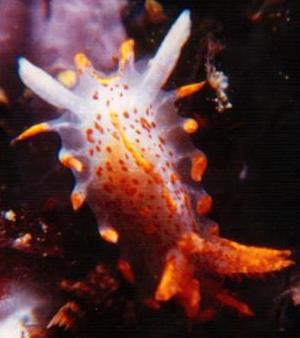
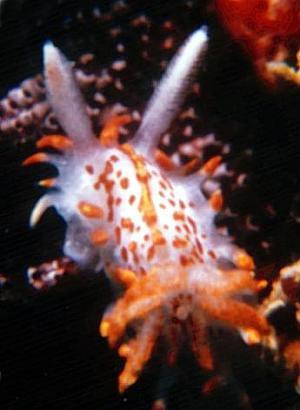
Okenia mediterranea
(von Ihering, 1886)
Order: NUDIBRANCHIA
Suborder: DORIDINA
Superfamily: ANADORIDOIDEA
Family: Goniodorididae
DISTRIBUTION
Mediterranean
PHOTO
La Cabrita Reef, Bay of Algeciras, Strait of Gibraltar, southern Spain at 26 m. depth. December, 2000, 12mm long. Photo: Alma Sánchez
Body is ovate with approximately 9 pairs of elongate papillae around the edge of the mantle. There is a ridge running down the dorsal midline from the rhinophores to the gills. The gills and rhinophores are relatively long. Grows to about 12mm long.
The common colour form is translucent white with orange-red and yellow markings, sometimes merging to orange, as shown in the accompanying photos. The mantle papillae are tipped in orange/yellow and the gills are similarly coloured. The median ridge is usually yellow with orange-red markings and orange-red marking are scattered over the dorsum and sides of the body. In a less common colour form there are only yellow markings. According to Cattaneo-Vietti et al (1990) this species feeds on gorgonians such as Paramuricea clavigera, but Cervera et al (1991) report finding specimens feeding on the ctenostome bryozoan Alcyonidium cf. mytili.
-
Cattaneo-Vietti, R., R. Chemello, & Giannuzzi-Savelli, R. (1990) Atlas of Mediterranean nudibranchs [Atlante dei nudibranchi del Mediterraneo], 264 pp., 14 pls. La Conchiglia: Rome.
-
Cervera, J.L., Lopez-Gonzalez, P.J. & Garcia-Gomez, J.C . (1991) Taxonomic and geographical range data on two rare species of Okenia (Gastropoda: Nudibranchia: Doridacea) from the esastern Atlantic. The Veliger, 34: 56-66.
-
von Ihering, H. (1886), Beitrage zur Kenntniss der Nudibranchien des Mittelmeeres, 2. 4, Die Polyceraden. Malakozool. Blatt. NF. 8: 12-48
-
Valdés, A. and Ortea, J. (1995) Revised taxonomy of some species of the genus Okenia Menke, 1830 (Mollusca: Nudibranchia) from the Atlantic Ocean, with the description of a new species. The Veliger, 38: 223-234.
Rudman, W.B., 2001 (February 25) Okenia mediterranea (von Ihering, 1886). [In] Sea Slug Forum. Australian Museum, Sydney. Available from http://www.seaslugforum.net/find/okenmedi
Related messages
Okenia sapelona? from Brazil
January 12, 2007
From: Vinicius Padula
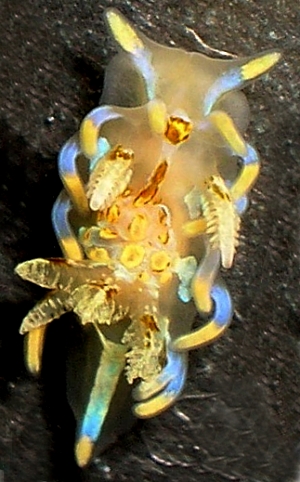
Dear Bill,
I believe that this is Okenia sapelona. It was found in the littoral of Rio de Janeiro, Brazil.
Locality: Rio de Janeiro, Brazil. Length: ~10 mm. Photographer: J. Alvim.
The picture matches the original description of Marcus and Marcus (1967) based on an animal from Sapelo Island, Georgia. As far as I know this record from Brazil is the first record of this species since Marcus's description.
Best wishes,
Vinicius Padula
viniciuspadula@yahoo.com
Padula, V., 2007 (Jan 12) Okenia sapelona? from Brazil. [Message in] Sea Slug Forum. Australian Museum, Sydney. Available from http://www.seaslugforum.net/find/19201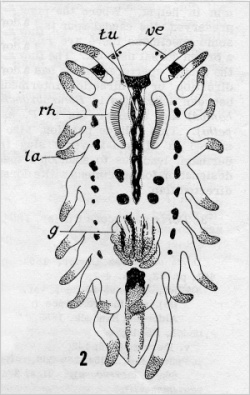
Dear Vinicius,
Thanks for this interesting photo. I had always thought Okenia sapelona was most probably just a west Atlantic specimen of Okenia mediterranea and on checking out the description while looking at your message I am even more convinced that it is. The animal is described as 'iridescent pale blue' which I assume means the animal was translucent whitish, and it had maroon rhinophores and maroon spots on the gills. The animal has yellow markings - as illustrated in black and grey stippling in the sketch alongside. Marcus & Marcus say it is closest to O. mediterranea but consider that that species differs in not having papillae in the dorsal midline. As can be seen in many photos on the Forum, O. mediterranea, like the Marcus sketch of O. sapelona, does have a median ridge with raised tubercles along its length. I suspect it is just one of many species found on both sides of the Atlantic. Another example which came to light through photos to the Forum is the west Atlantic speciesPolycera chilluna , which is almost certainly the same species as the east Atlantic Polycera aurantiomarginata.
Which brings me back to your animal. It is possible taht it is the same as O. sapelona but some differences make me hesitant. Although they both have the last pair of lateral papillae on each side sharing a joint base, the lateral papillae are much longer and fewer in number in your animal. Also, although their are similarities in colour, the bright blue bands on the lateral papillae and down the side of the head in your animal are quite different. It's possible that these are just part of the species' variability, but I would think it was worth checking the anatomy of your animal to see just how similar it is to more typical O. mediterranea.
ILLUSTRATION: Fig 2. Okenia sapelona from original description. Marcus, E. and E. Marcus. 1967. Some opisthobranchs from Sapelo Island, Georgia, U. S. A. Malacologia, 6: 199-222.
Best wishes,
Bill Rudman
Re: Color forms of Okenia mediterranea
March 8, 2006
From: Cristian Magnani
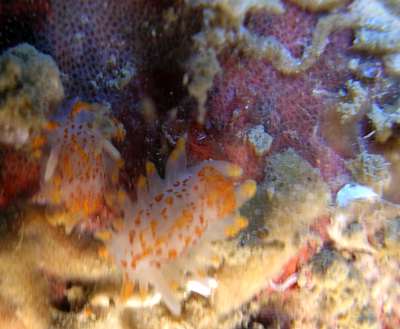
Concerning message #16033:
Dear Bill
Thanks for your interest. I was very surprised to know that Okenia mediterranea doesn't live on gorgonians. It says in a book by Egidio Trainito " Nudibranchi del Mediterraneo" ( Mediterranean nudibranches) that they do. Actually this books lacks some real pictures and the Okenia is depicted as a colour painting on [a photo of a] branch of deep water red gorgonian ( Paramuricea clavata). in another book "Mediterranen Fauna" by G. Nikiforos Okenia mediterranea is said to lives in "coral zone" the area deeper than 30 meters where gorgonians, encrusting sponges and coelentherates like Leptosammia purvoti lives.
I do believe you are right about the Alcyonidium bryozoan. I do believe the Okenia in my earlier photos are feeding upon Alcyonidium gelatinosum and the white hexagonal structure is the Alcyonidium skeleton while the living bryozoan is below the Okenia. Here is another photo where I think it is easier to see.
Thanks for your precious help Bill !
Nice dives!
Cristian
cristianmagnani@hotmail.com
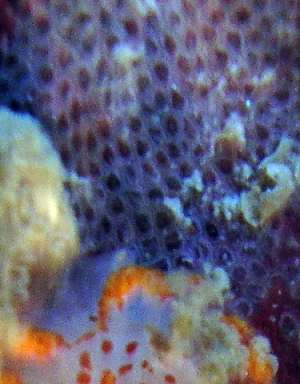
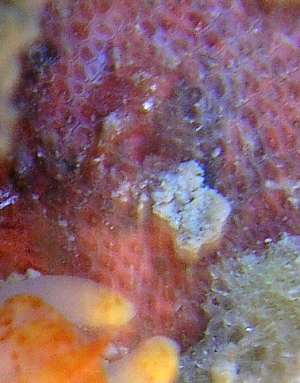
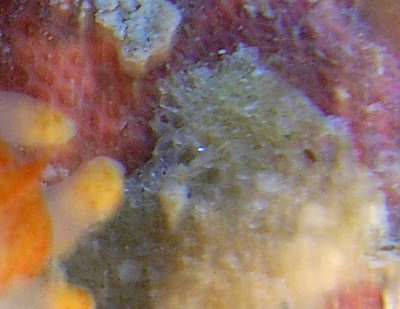
Dear Cristian,
I had noticed a couple of the 'photos' in Egidio Trainito's book looked as though the nudibranch was a pianting on a background photo of a 'real' food item. He really should mention this in the caption as I was not sure in the case of Okenia mediterranea, and so it reinforces an error. The idea that this species feeds on gorgonians seems to have started in the Atlas of Mediterranean nudibranchs.
I hadn't realised the brownish-white region in your photos was also part of the bryozoan colony. Thanks for the extra photo. It's nice to be able to confirm the report by Lucas Cervera and his colleagues that this species feeds on Alcyonidium.
- Cattaneo-Vietti, R., R. Chemello, & Giannuzzi-Savelli, R. (1990) Atlas of Mediterranean nudibranchs [Atlante dei nudibranchi del Mediterraneo], 264 pp., 14 pls. La Conchiglia: Rome.
Best wishes,
Bill Rudman
Color forms of Okenia mediterranea
March 7, 2006
From: Cristian Magnani
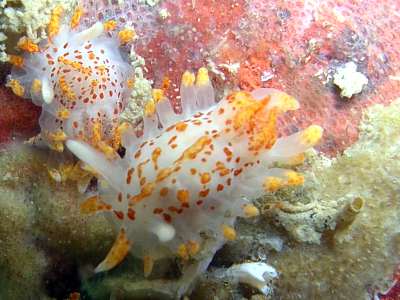
Dear Bill,
Last April 30 2005 while diving on a cargo shipwreck out of Numana on the Italian Adriatic coast we spotted a pair of Okenia mediterranea. We were so glad we had the chance to take a few picture of a nudibranch we had never seen before over there and a stunning one also. Once at home I was very impressed to find out that this slug usually lives on gorgonian. One week later we went back and we found another Okenia mediterranea but in a different color form. Unfortunately i didn't take their length but it was in the 6-7 mm range.
Locality: Numana, 12 metres, Italy, Mediterranean Sea, 04 May 2005, inside iron shipwreck . Photographer: Cristian Magnani.
I send you photos of both color forms
Thanks
Best regards
Cristian
cristianmagnani@hotmail.com
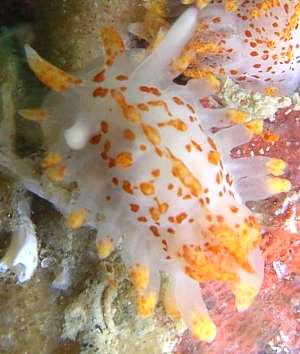
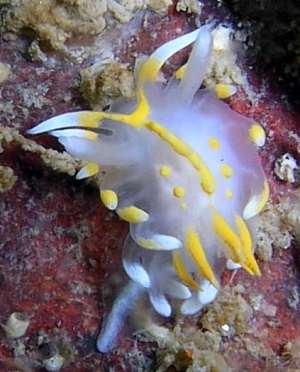
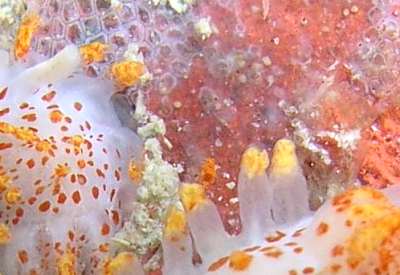
Dear Cristian,
Thanks for your beautiful photos of the two colour forms. They certainly are quite different in colour. I see Luis Tocino has the yellow colour form on his website [http://www.ugr.es/~lstocino/] of Granada opisthobranchs, but has it identified as O. elegans, which is a bit puzzling.
I am also puzzled by the reference to it feeding on gorgonians as most species of Okenia feed on bryozoans and a few on ascidians. Also it has been reported feeding on the ctenostome bryozoan Alcyonidium mytili [see Cervera et al (1991). In your photo of the red-orange spotted colour form your animals are on a reddish encrusting bryozoan. Although ctenostome bryozoans are usually fleshy, non calcareous, arborescent bryozoans, I think Alcyonidium mytili is a pink encrusting form so you might have recorded it on its bryozoan food. Even if it is not that species, it is a bryozoan, and I am pretty sure its presence on the bryozoan is not a coincidence. All in all you photos raise a number of interesting points. Are these colour forms the same species? Does this species really eat gorgonians? What is the bryozoan in your photo?
Lets hope someone can help,with some answers.
Best wishes,
Bill Rudman
Okenia mediterranea from Turkey
July 26, 2003
From: Haluk Akbatur
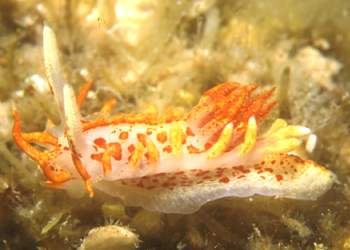
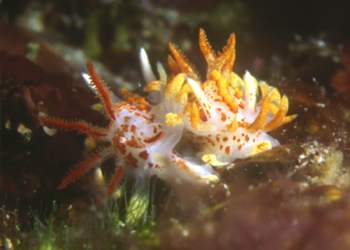
Dear Bill,
Here are some photos of Okenia mediterranea I found near the Platydoris argo in my earlier message.
Depth: 27 m.
Place: Kekova Is., Antalya, Turkey
Date: 4 July 2003
Thanks a lot,
Haluk
lasergoz@ttnet.net.tr
Akbatur, H., 2003 (Jul 26) Okenia mediterranea from Turkey. [Message in] Sea Slug Forum. Australian Museum, Sydney. Available from http://www.seaslugforum.net/find/10555Thanks Haluk,
This is another interesting find I suspect. I don't know of any records of this species so far east in the Mediterranean
Best wishes,
Bill Rudman
Okenia mediterranea from Spain
March 1, 2001
From: Alma Sánchez


Dear Dr. Rudman,
Here are two photos of Okenia mediterranea (von Ihering, 1886). The specimen was identified by Prof. Dr. Lucas Cervera.
This specimen was collected in December, 2000 at the Bay of Algeciras (Strait of Gibraltar, southern Spain) at 26 m. depth. Size: 12mm. Place: La Cabrita Reef
Best wishes,
Alma Sánchez
almasanchez83@hotmail.com
Sánchez, A., 2001 (Mar 1) Okenia mediterranea from Spain. [Message in] Sea Slug Forum. Australian Museum, Sydney. Available from http://www.seaslugforum.net/find/3868Dear Alma,
Thank you again for photos of yet another intersting and beautiful nudibranch from southern Spain.
Best wishes,
Bill Rudman
